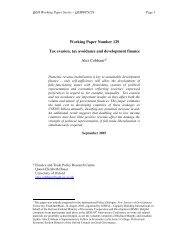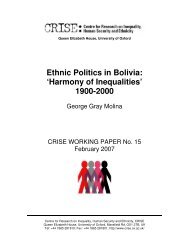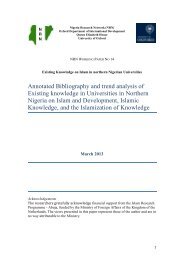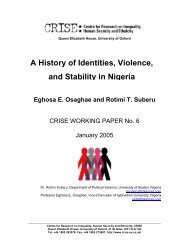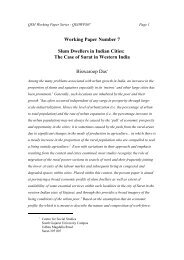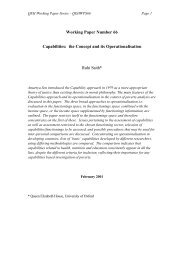Acute Multidimensional Poverty: A New Index for Developing ... - OPHI
Acute Multidimensional Poverty: A New Index for Developing ... - OPHI
Acute Multidimensional Poverty: A New Index for Developing ... - OPHI
You also want an ePaper? Increase the reach of your titles
YUMPU automatically turns print PDFs into web optimized ePapers that Google loves.
<strong>Acute</strong> <strong>Multidimensional</strong> <strong>Poverty</strong>: A <strong>New</strong> <strong>Index</strong> <strong>for</strong> <strong>Developing</strong> CountriesAlkire & Santosidentified as poor and who live in a household where at least a child died. Our estimate can be eitherhigher or lower than the mortality rate because a) it counts as deprived all people in households witha child death and not the actual children that died (both the numerator and the denominator aredifferent); b) it depends on the distribution of child mortality in the population and the size of thehouseholds with child mortality; 21 c) we consider as non-deprived households where no one wasinterviewed on mortality. 22 Once again, note that although considering the household as the unit ofanalysis is not ideal, it does have some intuitive meaning, because the household experiences anexternal negative effect by the death of a child.The MPI considers and weights standard of living indicators individually. It would also be veryimportant and feasible to combine the data instead into other comparable asset indices and exploredifferent weighting structures. The present measure uses six indicators which, in combination,arguably represent acute poverty. It includes three standard MDG indicators that are related tohealth, as well as to standard of living, and particularly affect women: clean drinking water,improved sanitation, and the use of clean cooking fuel. The justification <strong>for</strong> these indicators isadequately presented in the MDG literature. It also includes two non-MDG indicators: electricityand flooring material. Both of these provide some rudimentary indication of the quality of housing<strong>for</strong> the household. The final indicator covers the ownership of some consumer goods, each ofwhich has a literature surrounding them: radio, television, telephone, bicycle, motorbike, car,truck and refrigerator. We are aware that all the living standard indicators are means rather thanends; they are not direct measures of funtionings. Yet, they have two strengths. In the first place,unlike income, which can serve an incredibly wide range of purposes (and one never knows whetherit is used effectively to accomplish the needs considered to be basic), these are means very closelyconnected to the end (functioning) they are supposed to facilitate. Access to safe drinking waterserves directly to satisfy the need of hydration and hygiene (hygiene is also facilitated by the accessto improved sanitation and flooring material). Clean cooking fuel prevents respiratory diseases,which are a leading cause of preventable death, and contributes to a healthy home environment.Electricity is fundamental to pursue a number of activities. It allows lighting, which in turn allowspeople to be independent during the night time. Power also enables a wide range of work and leisureactivities ranging from refrigeration to drilling to blending, sewing, and so <strong>for</strong>th. Electricity is alsousually a safer means of lighting. And the set of considered assets are directly linked to the ability tocommunicate with other people, to be mobile, and even to have access to safe food. Secondly, mostof the indicators are related to the MDGs, which provides stronger grounds <strong>for</strong> their inclusion inour index.Of the ten indicators, all but one are relatively sensitive to policy change and measure ‘flow’, whichmeans they will reflect changes in-country with as little as one year between surveys. The exceptionto this is the stock indicator of child mortality. More direct measures of household healthfunctioning were simply not available. Other relatively stable indicators are years of schooling –which will be stable <strong>for</strong> many households who have no one in full-time education.21 If mortality is concentrated in a few households and the size of these households is not excessively large, our estimateswill tend to be lower than the standard measure. On the other hand if mortality is distributed one-per household, ourestimates will tend to be higher than the standard measure. For specific examples, please see the section on results.22 As explained by describing the eligible population <strong>for</strong> the mortality questionnaire in each survey (see footnote 22),many households in each survey were not asked the mortality questionnaire, and they are considered non-deprived inthis indicator. If we had restricted the in<strong>for</strong>mation only to households were the mortality questionnaire was asked, wewould have missed significant in<strong>for</strong>mation in the other indicators.www.ophi.org.uk July 2010 16



